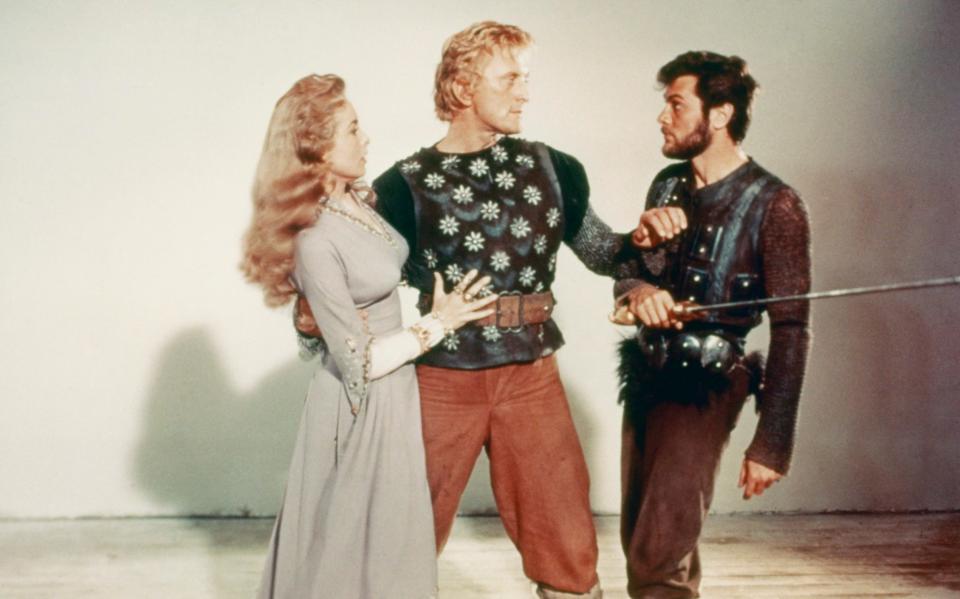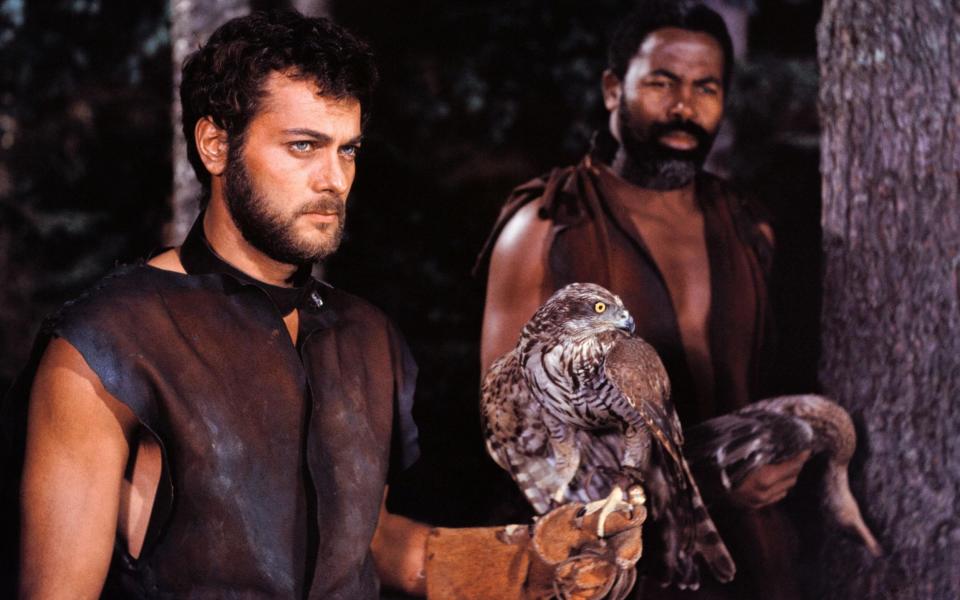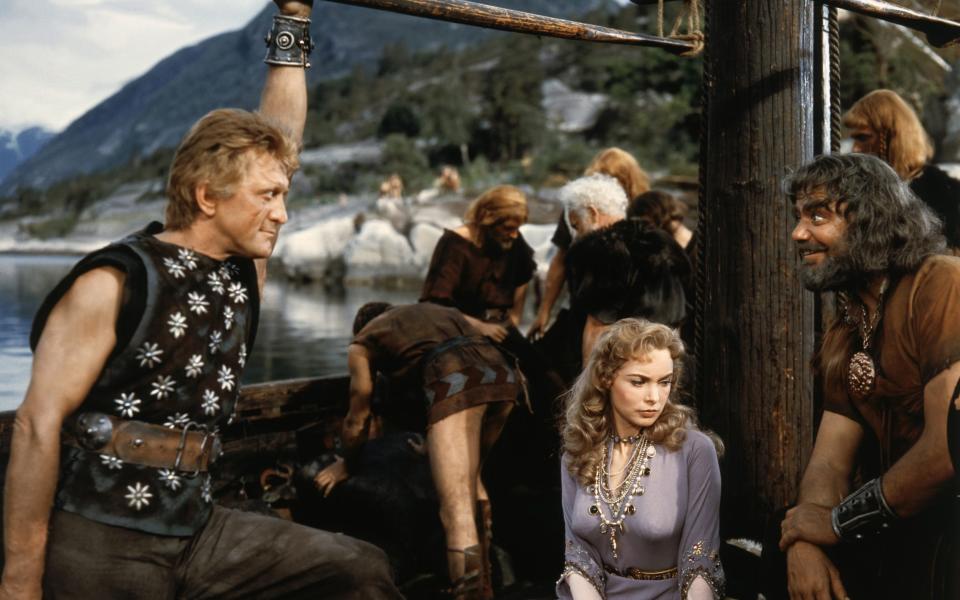Why The Vikings drove Kirk Douglas berserk

A day before the 1958 premiere of The Vikings, Kirk Douglas steered the longship of good publicity. He was hoisted almost 100ft above Times Square in a bosun’s chair and dangled alongside the world’s biggest film advertisement: a billboard shaped like a longship – 275ft long, in fact – that stretched across the Astor and Victoria theatres on Broadway.
The ship was accompanied by the giant faces of Douglas and his co-stars – Tony Curtis, Ernest Borgnine, and Janet Leigh – a testament to the kind of star power that just doesn’t exist now. In a stunt befitting the spectacle of The Vikings, Douglas hung in the air and christened the billboard with a bottle. Reports said it was a bottle of water from a Norwegian fjord; Douglas insisted it was champagne.
In the film, Douglas and Curtis play half-brothers – Einar (Douglas), a vicious Norse prince; and Eric (Curtis), a slave and rightful king of England. Unaware that they are brothers, the rivals are destined to clash over Janet Leigh’s pointy-breasted Welsh maiden. It’s a star-studded, sword-swinging love triangle.
But The Vikings belonged to Kirk Douglas. He was both leading man and producer, wielding a power and stormy disposition that caused the director, Richard Fleischer, to go by the mantra of “never work for a producer who is also the star”.
The Vikings was more than two years in the making – a glorious Technicolor mega-romp with replica longships, misty fjords and plenty of bearded men. Plus, plenty of hammy action and some occasionally hammy history. There’s no escaping that these Vikings are in fact bolshie Americans. Particularly amusing is jolly American icon Ernest Borgnine as Ragnar, father to Douglas’s Einar – despite Borgnine being just a year older than Douglas. Still, it doesn’t fall into the faux historical traps of other screen Vikings – there’s nary a horned helmet in sight.

The Vikings also troubled censors with its racy dialogue – “I’ll make her howl till they hear her in Wales!” – and eye-clawing, hand-chopping violence. “It was controversial for its time,” says Professor Kevin J. Harty, a lecturer on medieval literature at La Salle University and editor of The Vikings on Film. “It was the first major Viking film out of Hollywood in 30 years. It was a big star film that happened to be about Vikings… Like most medieval films from the Fifties, it’s really a western.”
Vikings are smashing and pillaging their way through the current cultural moment, with The Last Kingdom and Vikings: Valhalla on Netflix, and Robert Eggers’ The Northman now staking its claim as this generation’s Gladiator. While back in the late Fifties and early Sixties, Kirk Douglas’s Vikings inspired their own momentary cultural invasion: a short-lived TV spinoff, Tales of the Vikings, and a 1961 Italian knockoff, the Mario Bava-directed Erik the Conqueror.
Arguably, the current Viking fad owes a debt to Douglas too. Michael Hirst’s Vikings – the predecessor to Vikings: Valhalla – was born from an attempt to reboot the 1958 film for the 21st century. Though Hirst went in his own direction. He called Douglas’s The Vikings “one of the worst films in the world”.
The fascination with Vikings, says Kevin Harty, began in 19th Century England, as part of an effort to reclaim a new, purer English identity. “Battles over race and ethnicity,” says Harty. “If you were English, did you want to descend from the Normans? Or from the French? Or from somebody else? Why we like the Vikings is interesting, sometimes troubling. The Vikings represent whiteness in history. It’s this Nordic purity.”

The film was adapted from the Edison Marshall 1951 novel, The Viking – pulpy, sexed up, amusingly violent. Kirk Douglas had found Marshall’s book while scavenging for Viking-based material to adapt for the big screen. He took the project to bosses at United Artists, who agreed to a modest-but-not-inconsiderable budget of $3.25 million, as long as Douglas brought another bankable co-star onboard – ultimately Tony Curtis, plus Curtis’s then wife Janet Leigh.
Douglas also hired director Richard Fleischer, a blockbuster filmmaker who had enjoyed the experience of directing Douglas in the 1954 version of 20,000 Leagues Under the Sea and was keen to work with the star again. Fleischer, writing in his autobiography, noted that Douglas’s “upstaging habits were annoying, but he was, after all, a star. A real star.”
Fleischer was unimpressed with the initial script, by playwright Dale Wasserman, so Douglas hired an unnamed English writer for a rewrite. Fleischer set to work researching Viking history at the British Museum and enlisted various historical experts. “The whole pitch for The Vikings when it was made was that it was totally authentic – whether it was or not,” says Kevin Harty.
The Vikings would be shot along the 111-mile Hardangerfjord in Norway, with a purpose-built Norse village and three longships based on blueprints from the Viking Ship Museum in Oslo. Scores of bearded rowers were hired and given sunlamps, so they’d be good and bronzed when shooting began the following spring.

Fleischer found Douglas to be a passionate collaborator in pre-production, and one who was happy to spend money. Douglas was committed to authenticity – to an extent. The experts were there to help with everything, from the design of ships to the measurements of the Viking abodes, but they weren't entirely helpful in the end. “The experts disagreed, and finally I had to make the decisions myself,” Douglas recalled in his autobiography.
Douglas departed for Munich to shoot Stanley Kubrick’s WWI masterpiece Paths of Glory. Meanwhile, pre-production on The Vikings sailed along nicely. Fleischer was particularly happy with the new script, which was packed with powerful, cliché-free dialogue. That was until the director travelled to Munich for dinner with Douglas, Stanley Kubrick, Paths of Glory producer James Harris, and the screenwriter Calder Willingham.
The dinner turned into an ambush and ransacking. The dialogue – according to Douglas, Kubrick, and Co – needed rewriting. Fleischer argued against them, but the decision had already been made: Calder Willingham would rewrite the script. Fleischer headed to Norway to begin production, even shooting some footage, without a script to work from. He didn’t see the revised script until Douglas returned from filming Paths of Glory.

There were more script problems: the Production Code Administration (PCA), Hollywood’s self-censorship body, objected to numerous aspects. As detailed by Kathleen Coyne Kelly in an essay on the film, the PCA cited “brutality and possible gruesomeness”, “lustful kissing”, and “seduction or rape” as things it wanted removed or prohibted. Indeed, the sexual politics of The Vikings – Einar’s persistent attempts to rape Morgana (Janet Leigh), which are played like a brooding romance – are enough to make the horns on your helmet spin.
The PCA was particularly troubled by The Vikings’ most notorious scene: Douglas’s Einar having his left eye clawed out by a falcon, leaving him disfigured. Early on, the film makes light of Einar’s pristine, clean-shaven looks. “He’s so vain of his beauty he won’t let a man’s beard hide it,” says Ragnar. “He scrapes his face like an Englishman.”
“He’s a pretty boy,” says Harty about the character. “But you had to be careful how you said that in the Fifties.” In truth, Douglas wouldn’t grow a beard – he was the dimple-chinned hero of his day, and his face was the money-maker – but he did offer the other actors a $200 bonus to grow one.
When his character meets Tony Curtis’s Eric for the first time – a meek slave in exceedingly tight underpants – Eric sets his falcon on the bullish Einar. It claws at Einar’s eye – spoiling his pristine looks, leaving him half blind, and drawing the film’s only blood, a splash of red paint. The PCA was concerned not only with the “excessive gruesomeness” but also the treatment of the falcon. Watched now, the poor bird – gripped at the talons by Douglas and its beak taped shut – certainly gets its feathers ruffled.

It wasn’t the only animal that had a tough time. In a later scene, Ernest Borgnine’s Ragnar is thrown into a pit of wolves by Aella (Frank Thring), the sneering, cold-blooded King of Northumbria. The wolves were in fact German police dogs, who – despite a dog handler’s assurances – wouldn’t act ravenous and angry on cue. Fleischer tried to rile them up by electrifying the mesh flooring beneath them, then by dousing their backsides with turpentine. In the end, it was the sight of Tony Curtis wearing a comedy hat and blouse – which Curtis had whipped on for a laugh – that sent the dogs wild.
Kirk Douglas might not have been game for growing a beard, but he was determined to muck in with the stunts. In one scene, Einar “runs the oars” – a drunken game of hopping across the longship oars, which protrude from the side of the ship horizontally, as if they were stepping stones. Douglas, driven by either artistic integrity or pure machismo, insisted on doing it himself. Fleischer was reluctant to let him, but later conceded that Douglas was “far better than any of the stuntmen”. Douglas ran the oars twice and slipped into the water on his third attempt – deliberately, so Kirk claimed.
Fleischer had read about running the oars during his research in the British library. Other traditions were invented, such as one game in which an adulterous wench is forced into the stocks and has her pigtails tied up. The Vikings try to chop off the pigtails by launching axes at her head. If she cops a hatchet to the face, hard luck (she doesn't, mercifully). Indeed, these are Vikings from the barbaric tradition, as personified by Kirk Douglas – snarling his way through the film, ravaging women, always up for a ruck, drinking mead straight from the casket.
The image of Vikings as barbaric and bloodthirsty has been disputed by revisionist historians. “Were the Vikings terrorists of their day? I guess,” says Kevin Harty. “People were very much afraid of them. But if you look at the movie – especially the trailer – it makes them sound like the worst combination of Al-Qaeda, the Nazis, and everything else.” As Harty points out, the Vikings are not the only barbarians in the film. “The English aren’t much better!” laughs Harty. “It’s ‘Who savage now? Who’s badder?’” Indeed, King Aella not only throws Ragnar to the wolves, he also hacks off Tony Curtis’s hand to prove a point.
The filmmakers had problems with historical accuracy. The real Viking longships – which the film’s replicas were based upon – were built for much smaller men. “Vikings were smaller than people in the 20th Century,” says Harty. “The actors couldn’t row without hitting the people in front.” Every other oar hole had to be plugged up so the ships could be properly rowed. There were other design problems and the ships had to be powered by hidden diesel engines. “One thing we learned for sure,” wrote Richard Fleischer. “When the Vikings built their boats, they didn’t have movie work in mind at all.”
More boats were needed to lug the cast, crew, and equipment up and down the fjord: two dormitory boats, a special effects boat, a wardrobe boat, a props boat, and an electrical supplies boat. The captains of the dorm boats – one Danish captain, one Norwegian captain – got competitive and tried to out-pace and out-maneuverer each other. The boats would collide and were left banged-up, dinged, and dented.

There were clashes on land too. Douglas was temperamental and quick to blow up at Fleischer. Douglas even erupted over which way he should cross his arms for one particular shot. Tony Curtis, writing in his memoir, also recalled that “you also had to be careful not to upset [Kirk] or he would cut your lines out of the script. And since he was making the picture, he always made sure he was the most important actor in the movie.”
Morale was low – “[Kirk] was probably unaware that he was the cause of most of it,” wrote Fleischer – so the stars put on a variety show for the crew. There was uproarious, drunken laughter as Douglas, Curtis, Leigh, and Borgnine did a slapstick routine, with Douglas getting dozens of custard pies in the face. But the next day, the Norwegian crew tried to strike, demanding more money. Douglas described the incident in his autobiography. After the camaraderie of the previous night, he was outraged and moved the production to studios in Munich. He wouldn’t even negotiate with the Norwegians.
Fleischer remembered it differently: that Douglas was already planning to move production to Munich to escape the bad Norwegian weather – which had hammered the shooting schedule for weeks by that point – and was about to lay off the crew anyway, a detail that Douglas forgot in his outrage. The attempted mutiny, as Fleischer told it, was conveniently timed.

For the final battle – in which the Vikings assault the English to avenge the death of Ragnar – production moved to Fort-la-Latte, a 14th Century castle in Brittany. It’s the last of the film’s stunningly shot locations – Jack Cardiff’s cinematography is stirringly majestic throughout – but not exactly authentic. As noted by historian Alex von Tunzelmann in the book, Reel History: “A pedant might point out that medieval castles weren't built pre-ruined.”
The action in The Vikings might look hokey now – it’s swashbuckling fare to the very end – but it’s hard not to get swept away by the rousing call to arms in its final act: the Viking ships emerging from the mists on their way to England; the commanding horns of Mario Nascimbene’s score; and the battle itself. Learning that they are in fact half-brothers, the one-eyed Einar and one-handed Eric fight to the death atop the castle tower. Douglas’s death scene is exquisite: stuck in the gut with a snapped-in-half blade, he cries out “Odin!” and collapses – with a sword clutched in his hand to ensure entry into Valhalla.
Janet Leigh recalled that the stunts Douglas and Curtis performed for the sequence made her “sick with worry”. Elsewhere, Curtis was hospitalised after getting a rogue arrow in the eye. And the film's closing sequence – Einar’s body being sent out to sea on a burning longship – was almost a disaster.
Fleischer filmed the shot at the end of pre-production, before the actors had turned up. He was supposed to use a miniature boat, but it didn’t look convincing enough. Instead – and without permission (or, more crucially, insurance) – he rigged one of their actual longships with gas jets to give the illusion that it was engulfed in flames. Due to a miscommunication and faulty water pumps, the wooden ship caught alight and almost burned for real. “The burning funeral ship is a memorable shot in the movie,” Fleischer recalled. “It should be. It was almost my funeral.”
The Viking funeral is authentic enough – “There’s credible evidence for that happening both on land and on sea,” says Kevin Harty – and created a movie trope. Even non-Vikings can get a Viking funeral in Hollywood. “It gets appropriated in the Sean Connery and Richard Gere film First Knight,” says Harty. “Connery's King Arthur is given a Viking funeral!”
Premiering on June 11, 1958, The Vikings was – in Kirk Douglas’s own words – a “tremendous hit”. Kirk Douglas was so proud that he took his dear mum to see the longship billboard. Douglas had named his production company, Bryna, after her. A Russian immigrant from a family of Ukrainian farmers, her name was now in lights.
The Vikings might have said as much about Fifties Hollywood as it did real Viking history, much like the current Viking resurrection might have something to say about the troubled present. Vikings go with the times. As Kevin Harty says: “We constantly reinvent the past to suit our present purposes.”


